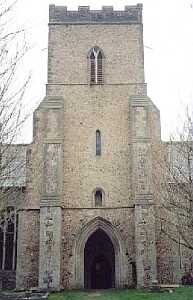
The church of All Saints in the parish of Thorndon, in the hundred of Hartismere, Suffolk, was built
by Robert de Ufford,
He played a leading part in the suppression of the Peasants' Revolt in 1381, but in the same year he supported the popular party in parliament in the attack on the misgovernment of Richard II. Although twice married he left no sons, and his earldom became extinct, his extensive estates reverting to the Crown.
|
Robert was granted title to his fathers lands in 1318 although he was under age, Edward II granted them after homage and his mothers in 1325, although he was in Gascony. Robert fought at the battle of Boroughbridge 1322. Robert also obtained a grant for life of the town and castle of Oreford. Robert was involved with the capture of Queen Isabella and Roger Mortimer in 1330 at Nottingham Castle, by entering through a secret passage. Edward III rewarded him with £200 of lands, by appointing him keeper of the forests south of Trent and later he was made steward of the royal household. He was summoned to Parliament by Edward III, from 1331-1336. Robert took part in the Dunstable Tournament, 1334. Edward III made Robert 1st earl of Suffolk 16 March 1336 with the grant of £20.00 per annum from the revenues of Suffolk. Edward III also gave the Manor of Base court, in the parish of S. Giles without Cripplegate of London, commonly called the Barbican to Robert in 1336.
In January 1337 Robert was appointed an Admiral. Robert was one of the principal commanders of Edward III and went on a diplomatic mission to the King of France in 1338 and with the Count of Flanders in 1339. In an ambush near Lille in 1340 Robert was captured with the Earl of Salisbury and taken to Paris as a prisoner, but was back in England that year, apparently tyhe release was obtained with the help of King John of Bohemia.
Robert was back serving in France in 1341. Robert was Admiral of the Fleet north of the Thames, and he may have played a part in the great naval victory of Sluys in 1340. In 1343, he was one of the envoys appointed to treat with the Pope and from 1344 - 47 Robert was frequently in France. Robert provided a Banneret, 36 Knights, 58 Esquires and 63 Archers for the King's army. Robert was a Marshal of the army, and fought at Crecy 1346 and at the capture of Calais in 1347.
Robert was appointed to treat for peace with the French in 1350 and Robert fought at Poitiers in 1356. An indenture dated at Westminster 10 July 1355, between the King and Prince Edward, stipulated that the Prince's retinue would be paid by the king for 6 months in advance from the day of their embarkation and should conisist of the Earls of Warwick, Suffolk, Oxford and Salisbury, Sir John de Lisle and Sir Reginald de Cobham, 433 men-at-arms and 700 archers, of whom 400 should be mounted and 300 on foot. During the campaign of 1355 he led the rearguard with the Earl of Salisbury and spent the winter at Saint-Emilion. Next year again he led the rearguard led the rearguard at the battle of Poitiers with the Salisbury.
He was knighted in 1348 in the The Most Noble Order of the Garter after the death of Richard Fitzsimon
The church of All Saints in the parish of Thorndon, in the hundred of Hartismere, Suffolk, was built by Robert de Ufford, Earl of Suffolk, in 1358. In 1369 Robert de Ufford died, according to his will he was buried in Campsey Priory. To his son William he left his sword with which Edward III had created him the Earl of Suffolk.
|
Robert is mentioned in the book, Sir Nigel by Arthur Conan Doyle "It was the famous Robert de Ufford, Earl of Suffolk, who had fought without a break from Cadsand onward through the whole Continental War"